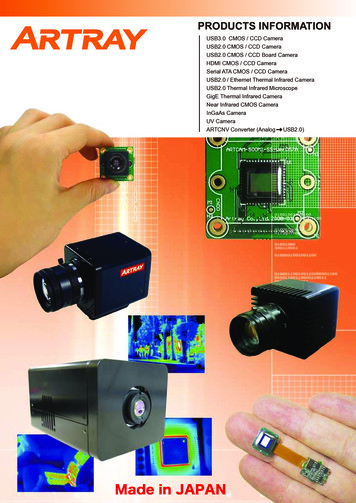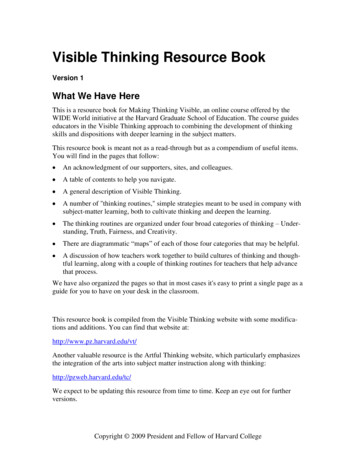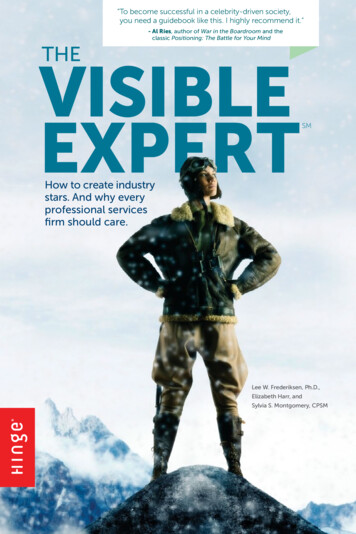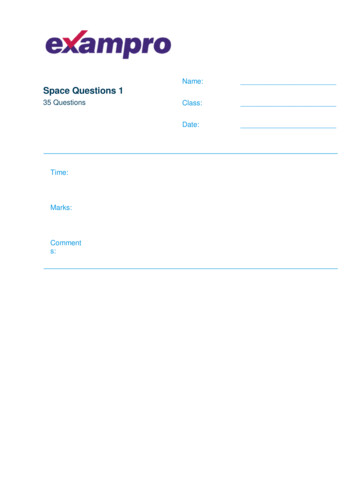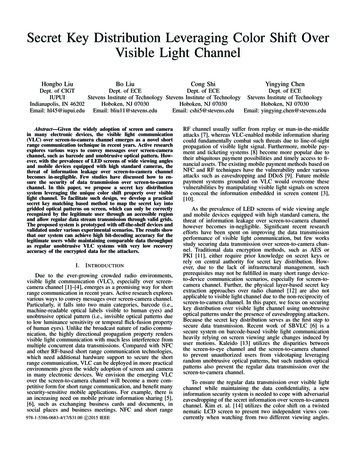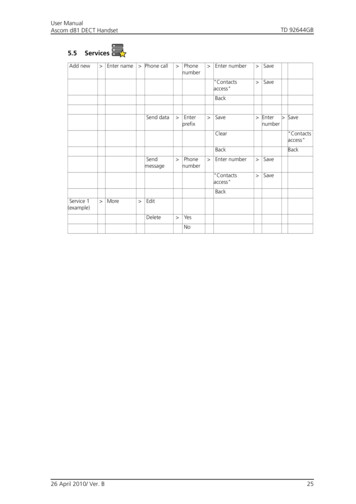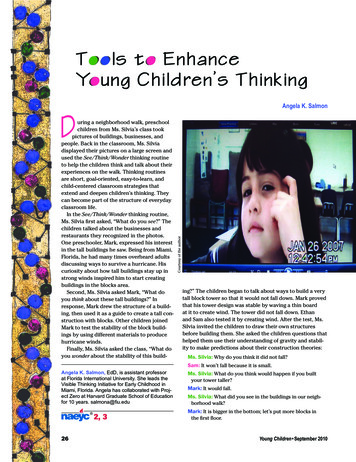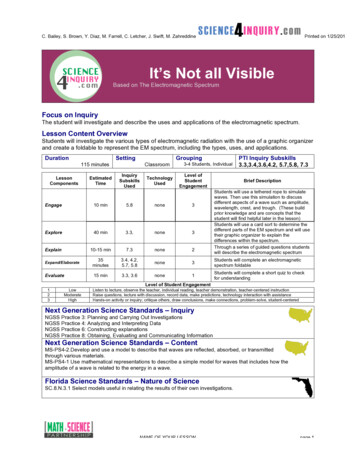
Transcription
C. Bailey, S. Brown, Y. Diaz, M. Farrell, C. Letcher, J. Swift, M. ZahreddinePrinted on 1/25/2017It’s Not all VisibleBased on The Electromagnetic SpectrumFocus on InquiryThe student will investigate and describe the uses and applications of the electromagnetic spectrum.Lesson Content OverviewStudents will investigate the various types of electromagnetic radiation with the use of a graphic organizerand create a foldable to represent the EM spectrum, including the types, uses, and applications.DurationSettingGrouping115 rySubskillsUsedTechnologyUsed3-4 Students, IndividualLevel ofStudentEngagementPTI Inquiry Subskills3.3,3.4,3.6,4.2, 5.7,5.8, 7.3Brief DescriptionStudents will use a tethered rope to simulatewaves. Then use this simulation to discussdifferent aspects of a wave such as amplitude,wavelength, crest, and trough. (These buildprior knowledge and are concepts that thestudent will find helpful later in the lesson)Students will use a card sort to determine thedifferent parts of the EM spectrum and will usetheir graphic organizer to explain thedifferences within the spectrum.Through a series of guided questions studentswill describe the electromagnetic spectrumEngage10 min5.8none3Explore40 min3.3,none3Explain10-15 min7.3none2Expand/Elaborate35minutes3.4, 4.2,5.7, 5.8none3Students will complete an electromagneticspectrum foldableEvaluate15 min3.3, 3.6none1Students will complete a short quiz to checkfor understandingLevel of Student Engagement123LowModerateHighListen to lecture, observe the teacher, individual reading, teacher demonstration, teacher-centered instructionRaise questions, lecture with discussion, record data, make predictions, technology interaction with assistanceHands-on activity or inquiry; critique others, draw conclusions, make connections, problem-solve, student-centeredNext Generation Science Standards – InquiryNGSS Practice 3: Planning and Carrying Out InvestigationsNGSS Practice 4: Analyzing and Interpreting DataNGSS Practice 6: Constructing explanationsNGSS Practice 8: Obtaining, Evaluating and Communicating InformationNext Generation Science Standards – ContentMS-PS4-2.Develop and use a model to describe that waves are reflected, absorbed, or transmittedthrough various materials.MS-PS4-1 Use mathematical representations to describe a simple model for waves that includes how theamplitude of a wave is related to the energy in a wave.Florida Science Standards – Nature of ScienceSC.8.N.3.1 Select models useful in relating the results of their own investigations.NAME OF YOUR LESSONpage 1
C. Bailey, S. Brown, Y. Diaz, M. Farrell, C. Letcher, J. Swift, M. ZahreddinePrinted on 1/25/2017Florida Science Standards – ContentSC.8.E.5.11 Identify and compare characteristics of the electromagnetic spectrum, such as wavelength,frequency, use, and hazards, and recognize its application to an understanding of planetary images and satellitephotographs.Materials and Advance PreparationMaterials ListClass set: Scissors (one per student) Coloring pencils, crayons or markers Ruler (one per group)Student materials: One piece of copy paper per student Blackline Master # 1 (one set per group of 3-4) Blackline Master # 2 (one per student) Blackline Master # 3 (one per student)Blackline Masters1. Electromagnetic Spectrum Card Sort2. Electromagnetic Spectrum Graphic Organizer3. Electromagnetic Spectrum Card Sort ANSWER KEY4. Electromagnetic Spectrum Graphic Organizer ANSWER KEY5. Check For Understanding: The Electromagnetic SpectrumAdvance Preparation1. Tie a length of rope (6ft - 10ft) to a stationary object such as a doorknob, chair, drawer handle,etc. 1 rope per each group of 4 - 6 students.2. Copies of blackline MastersLesson InformationLearning Objectives1. The student will be able to compare, and/or contrast the variety of types of radiation present inradiation from the Sun.2. The student will be able to identify and/or compare characteristics of the electromagnetic spectrumincluding relative wavelengths, frequencies and energy levels.3. The student will be able to identify common uses and/or applications of electromagnetic waves.Prior Knowledge Needed by the Students Basic understanding of the types of radiations from the Electromagnetic Spectrum.Visible light and its color spectrum.Background InformationElectromagnetic Spectrum is a range of different types of radiations that includes radio waves,microwaves, infrared, visible light, ultraviolet, x-rays and gamma rays. Each range of the EMSNAME OF YOUR LESSONpage 2
C. Bailey, S. Brown, Y. Diaz, M. Farrell, C. Letcher, J. Swift, M. ZahreddinePrinted on 1/25/2017(Electromagnetic Spectrum) has several applications and uses in everyday life. All the radiation types aredistinguished by its own wavelength and frequency; radio wave having the longest wavelength and lowestfrequency while gamma rays have the shortest wavelength and highest frequency. The visible light is theonly radiation visible and when it pass through a prism it separate into different colors. The colors of therainbow are in a specific order based on their wavelength (red, orange, yellow, green, blue, indigo, andviolet).Lesson ProcedureEngageInclude guiding questions you might ask to help students. If you use a video (include the URL in your lesson plan instructions) ora book (the author, title and publication date), and include questions that you would ask before, during or after the video/bookreading selection.1. Instruct students to hold the end of the rope with their hand at their waist.2. Ask students to back up so that the drooping rope just touches the floor.3. Discuss the characteristics of the hanging rope.Question: What does the shape of the rope look like in a resting position?Question: How much energy do you need to use to keep the rope in this resting position?4. Ask students to slowly and gently move the hand holding the rope up and down (about one foot between topand bottom).5. Discuss the characteristics of the rope.Question: What is the shape of the rope now?Question: How has it changed?Question: How has the energy needed to move the rope changed?6. Ask the students to increase the distance between the top and bottom but to keep the same speed.7. Discuss changes in the characteristics of the ropeQuestion: What is the shape of the rope now?Question: How has it changed?Question: How has the energy needed to move the rope changed?8. Ask the students to increase the speed of the rope.9. Discuss the characteristics of the rope.Question: What is the shape of the rope now?Question: How has it changed?Question: How has the energy needed to move the rope changed?ExploreThis should be a student-centered, hands-on activity that teaches your students about science. No lectures or direct teachingallowed. Please be as hands-on as possible. Also, please provide enough detail so that Dr. Blanchard could teach your lessonbased on what you have included in these steps.1.2.3.4.5.6.Each group of students will receive 1 envelope. Inside the envelope are the different types ofElectromagnetic waves and pictures that correspond to each energy type. Blackline Master #1.See sheet below for answers.Allow students to match the pictures to the definition of the type of Electromagnetic wave theybelong to (based on prior knowledge). Instruct students to keep the cards on their desk once theyhave them matched.Once students have all pictures and Electromagnetic wave types matched, have them raise theirhands for you to come to check their work. Instruct students to keep the cards together once theyhave the order correct.If there are wrong matches, silently un-match those words and have students correct them untilall pairs are correctly matched.Have students write a working definition and draw a picture(s) in the space provided on BlacklineMaster #2. See sheet below for answers.Have students highlight words within the definition that help them remember what each type ofElectromagnetic wave is.NAME OF YOUR LESSONpage 3
C. Bailey, S. Brown, Y. Diaz, M. Farrell, C. Letcher, J. Swift, M. ZahreddinePrinted on 1/25/2017ExplainInclude guiding questions you might ask students during the EXPLORE activity. You should have at least 10-15 questions toguide student discussion and learning.Some questions you might ask students include,1. Where does the radiation of the electromagnetic spectrum originate from?2. Are all wavelengths and frequencies the same? Explain your reasoning.3. Are there different types of waves in the spectrum? Are they in a specific order? How is thatorder determined? What would that order be?4. Which electromagnetic wave has the longest wavelength?5. Which electromagnetic wave has the shortest wavelength?6. What wave property increased as the wavelength decreased?7.What happens to the energy as the wavelength decreases?8. What is the order the colors in the visible light spectrum? Where would the infrared andultraviolet fit in the electromagnetic spectrum?ExpandInclude a similar student centered activity that will allow students to practice or connect what they have just learned in Explore.This is not an opportunity to introduce a new topic, but to provide enrichment on the topic of this lesson.1. Take a piece of paper and fold it in half (hot dog). Lay a ruler down along the top of the foldedside and fold it back up over the ruler, make six even cuts to make seven even flaps. (seeexample le%201.JPG2. After discussing the instructions for the foldable, have the students cut and label all the parts ofthe foldable.3. When students have their foldable cut and labeled discuss with the students each part of theelectromagnetic spectrum, as each wavelength is discussed the students will fill up each sectionof the foldable.4. Parts of the foldable:a. Name of wavelengthb. Definition and world applications for the specific wavelengthc. Nonlinguistic representation for each wavelength.EvaluateFORMAL EVALUTIONa. Attach a FORMAL EVALUATION (1-3 questions) on a separate sheet of paper that you have developed to use asyour evaluation tool.b. For each question, identify in parentheses at the end of the criteria the GLE (GLE# ) and/or Learning Objective(LO# ) you are assessing for your lesson. If you use an Inquiry GLE, please note it as INQ GLE # .INFORMAL or OPTIONAL EVALUTIONS1.WRAP UP.Bring the lesson to a conclusion by watching the Electromagnetic Spectrum Song Mr. Parr videowhich summarizes the lesson.https://www.youtube.com/watch?v P PVz8HrrCIYou can include an exit ticket referencing the video.Supplementary ResourcesInclude links to resources that the teachers and students might find useful in learning more about this topic.NAME OF YOUR LESSONpage 4
C. Bailey, S. Brown, Y. Diaz, M. Farrell, C. Letcher, J. Swift, M. ZahreddinePrinted on 1/25/2017Each resource should be in APA citation style and be followed with a one sentence annotation that notes appropriate age orgrade level.TeachersAn alternative foldable activity is available nts can use http://chromoscope.net/ to view a visual representation of 8 differentwavelengths.CITATION OF SOURCES.Where did you get the idea/materials for this lesson?(Put the author/date/book name or the Name of the website andthe complete URL). I/We used the following resources to build our lesson:Based on (APA format please)Sources Sort Card Pictures:Antenna and Radio Waves http://www.wpclipart.com/signs symbol/assorted/assorted 3/antenna and radio waves.pngMicrowaves ploads/2014/06/microwave.jpgInfrared Waves tion lanczos-none&fit around%7C300:200&crop 300:200;*,*Visible Light /original/Spectrum-Prism-sm.jpg?interpolation lanczosnone&fit around%7C300:200&crop 300:200;*,*Ultraviolet Waves g.stgaynor.com/2011/06/20110629-105458.jpgXray Waves –http://www.davidlnelson.md/images/Xray normal hand PA.jpgGamma Waves AAAAAAABGc/eyXzUvKAsig/s1600/pet scan pictures 3.jpgElectromagnetic spectrum answers/NAME OF YOUR LESSONpage 5
C. Bailey, S. Brown, Y. Diaz, M. Farrell, C. Letcher, J. Swift, M. Zahreddineü Yes, I cited all materials and resources used in this lesson.Printed on 1/25/2017Candace BaileyLesson author signatureBlackline Master # 1 Electromagnetic Spectrum Card SortNAME OF YOUR LESSONpage 6
C. Bailey, S. Brown, Y. Diaz, M. Farrell, C. Letcher, J. Swift, M. ZahreddinePrinted on 1/25/2017Radio Waves :This is part of the EM spectrum that emits thelongest wavelengths and lowest frequency ofradiation waves.Examples of radio waves include long distancecommunication, television transmission,satellites, walkie talkies, and listening to theradio.Microwaves :This is part of the EM spectrum that is basically ahigh frequency radio wave which is easilyfocused into narrow beams.Examples of microwaves include cell phonetransmission, blue tooth, wifi, xbox, cooking, andradar.Infrared Waves :This is part of the EM spectrum we are most oftenexposed to. It is invisible to humans, but we feelit as heat.Examples of Infrared waves include changing thechannels on our televisions, thermal imaging forweather reporting, remote controls, room heaters,and night vision goggles.NAME OF YOUR LESSONpage 7
C. Bailey, S. Brown, Y. Diaz, M. Farrell, C. Letcher, J. Swift, M. ZahreddinePrinted on 1/25/2017Visible Light Waves:This is part of the EM spectrum that humans cansee (ROY-G-BIV – Red, Orange, Yellow – Green– Blue, Indigo, Violet)., and visible light falls inthe middle of the spectrum.Examples of visible light waves include rainbows.Ultraviolet Waves :This is part of the EM spectrum that is invisibleto humans, yet many insects use this.Examples of ultraviolet waves include theauroras, sunburn, a cause of skin cancer, andblack lights.X-ray Waves :This is part of the EM spectrum that is invisibleto humans and is known to affect cell division.Examples of x-rays include medical diagnosis,radiation therapy, measuring constructionintegrity, laser refinement, archeology, andTSA monitoring.NAME OF YOUR LESSONpage 8
C. Bailey, S. Brown, Y. Diaz, M. Farrell, C. Letcher, J. Swift, M. ZahreddinePrinted on 1/25/2017Gamma Waves :This is part of the EM spectrum that has theshortest wavelength and highest frequency ofradiation waves.Examples of gamma waves include medicalradiation treatment, CT scans, and sterilizingmedical tools.NAME OF YOUR LESSONpage 9
C. Bailey, S. Brown, Y. Diaz, M. Farrell, C. Letcher, J. Swift, M. ZahreddinePrinted on 1/25/2017Blackline Master #2Electromagnetic Spectrum Graphic -rayGammaBlackline Master # 3 Answer KeyNAME OF YOUR LESSONpage 10
C. Bailey, S. Brown, Y. Diaz, M. Farrell, C. Letcher, J. Swift, M. ZahreddinePrinted on 1/25/2017Radio Waves :This is part of the EM spectrum that emits thelongest wavelengths and lowest frequency ofradiation waves.Examples of radio waves include long distancecommunication, television transmission,satellites, walkie talkies, and listening to theradio.Microwaves :This is part of the EM spectrum that is basically ahigh frequency radio wave which is easilyfocused into narrow beams.Examples of microwaves include cell phonetransmission, blue tooth, wifi, xbox, cooking, andradar.Infrared Waves :This is part of the EM spectrum we are most oftenexposed to. It is invisible to humans, but we feelit as heat.Examples of Infrared waves include changing thechannels on our televisions, thermal imaging forweather reporting, remote controls, room heaters,and night vision goggles.NAME OF YOUR LESSONpage 11
C. Bailey, S. Brown, Y. Diaz, M. Farrell, C. Letcher, J. Swift, M. ZahreddinePrinted on 1/25/2017Visible Light Waves:This is part of the EM spectrum that humans cansee (ROY-G-BIV – Red, Orange, Yellow – Green– Blue, Indigo, Violet)., and visible light falls inthe middle of the spectrum.Examples of visible light waves include rainbows.Ultraviolet Waves :This is part of the EM spectrum that is invisibleto humans, yet many insects use this.Examples of ultraviolet waves include theauroras, sunburn, a cause of skin cancer, andblack lights.X-ray Waves :This is part of the EM spectrum that is invisibleto humans and is known to affect cell division.Examples of x-rays include medical diagnosis,radiation therapy, measuring constructionintegrity, laser refinement, archeology, and TSAmonitoring.NAME OF YOUR LESSONpage 12
C. Bailey, S. Brown, Y. Diaz, M. Farrell, C. Letcher, J. Swift, M. ZahreddinePrinted on 1/25/2017Gamma Waves :This is part of the EM spectrum that has theshortest wavelength and highest frequency ofradiation waves.Examples of gamma waves include medicalradiation treatment, CT scans, and sterilizingmedical tools.NAME OF YOUR LESSONpage 13
C. Bailey, S. Brown, Y. Diaz, M. Farrell, C. Letcher, J. Swift, M. ZahreddinePrinted on 1/25/2017Blackline Master #4Electromagnetic Spectrum Graphic Organizer ANSWER KEYRadioMicrowaveThis is part of the EM spectrum that emitsthe longest wavelengths and lowestfrequency of radiation waves.This is part of the EM spectrum that isbasically a high frequency radio wavewhich is easily focused into narrow beams.Examples of radio waves include longdistance communication, televisiontransmission, satellites, walkie talkies, andlistening to the radio.Examples of microwaves include cellphone transmission, blue tooth, wifi, xbox,cooking, and radar.InfraredVisibleThis is part of the EM spectrum we aremost often exposed to. It is invisible tohumans, but we feel it as heat.This is part of the EM spectrum thathumans can see (ROY-G-BIV – Red,Orange, Yellow – Green – Blue, Indigo,Violet)., and visible light falls in the middleof the spectrum.Examples of Infrared waves includechanging the channels on our televisions,thermal imaging for weather reporting,remote controls, room heaters, and nightvision goggles.Examples of visible light waves includerainbows.UltravioletX-rayThis is part of the EM spectrum that isinvisible to humans, yet many insects usethis.This is part of the EM spectrum that isinvisible to humans and is known to affectcell division.Examples of ultraviolet waves include theauroras, sunburn, a cause of skin cancer,and black lights.Examples of x-rays include medicaldiagnosis, radiation therapy, measuringconstruction integrity, laser refinement,archeology, and TSA monitoring.GammaThis is part of the EM spectrum that has the shortest wavelength and highest frequency ofradiation waves.Examples of gamma waves include medical radiation treatment, CT scans, and sterilizingmedical tools.NAME OF YOUR LESSONpage 14
C. Bailey, S. Brown, Y. Diaz, M. Farrell, C. Letcher, J. Swift, M. ZahreddinePrinted on 1/25/2017Blackline Master # 5Check For Understanding: The Electromagnetic Spectrum1. If Rick is talking on his cellphone what type of electromagnetic waves is his cellphone using toconnect and communicate? (LO #3)a. gamma raysb. microwavesc. radio wavesd. visible light2. A thunderstorm has just passed and the sun is coming out. Maria is at the school track field andshe observes a rainbow at a distance. What type of electromagnetic wave is causing thisphenomena? (LO #2)a.b.c.d.infrared raysultraviolet wavesx-raysvisible light3. You are going on vacation during summer to Hawaii and you pack some sunscreen to protectyour skin from a sunburn. The sunscreen is protecting your skin from which wavelength? (LO #3)a.b.c.d.radio wavesx-raysultraviolet lightgamma rays4. Jimmy is doing a poster of the electromagnetic spectrum and he needs to show the relationshipbetween the frequency and wavelength of the EMS waves. Which statement best describes thatrelationship? (INQ GLE 3.6) (LO #2)a. The wavelength decreases as the frequency decreases.b. The wavelength increases as the frequency increases.c. The wavelength decreases as the frequency increases.d. The wavelength and frequency remains constant.Using the diagram above answer the following questions.5. When you are sick the doctor gives you a treatment or order some medicines. He has to assign youseveral tests and make you go through a process of examination to help you get better. Identify oneregion of the electromagnetic spectrum used by medicine and explain how is used. (LO #3)NAME OF YOUR LESSONpage 15
C. Bailey, S. Brown, Y. Diaz, M. Farrell, C. Letcher, J. Swift, M. ZahreddinePrinted on 1/25/20176. Choose one of the following to answer.a. Select between radio waves and infrared and give one useful application of this spectral region.(LO #3)b. Explain how visible light is different from other parts of the spectrum.(INQ GLE 3.3) (LO #1)Answer Key:1. b- microwaves2. d- visible light3. c-ultraviolet light4. c- The wavelength decreases as the frequency increases.5. a- x-rays broken bone scanning, gamma rays cancer treatment/ chemotherapy6 a. - radio waves listening music, watch TV, long distance communication, walky-talkiesinfrared rays remote controls, room heater, weather report, toaster, night vision gogglesb.- Visible light is the only type of radiation that you can see. When the visible light hits a prism it willseparateinto the rainbow colors (red, orange, yellow, green, blue indigo, violet) because of the differentwavelength that each color has.NAME OF YOUR LESSONpage 16
belong to (based on prior knowledge). Instruct students to keep the cards on their desk once they have them matched. 3. Once students have all pictures and Electromagnetic wave types matched, have them raise their hands for you to come to check their work. Instruct students to keep the cards together once they have the order correct. 4.

